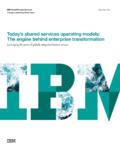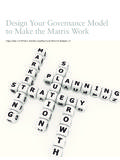Transcription of What Data Governance Model Is Right for Your …
1 S p e c i a l f e at u r e| Governance , risk, and complianceReproduced from the Oct n Nov n Dec 2007 issue of SAP Insider with permission from the publisher, Wellesley Information Services (WIS) | Subscribe today at KennedyFounder,BackOffice Associates & CEO, CranSoft, Data Governance Model Is Right for Your Company?Sound GRC Initiatives Rely on Quality DataAn essential element of any successful corporate Governance , risk, and compliance (GRC) initiative is quality data. The accuracy of all GRC-related analysis depends on the under-lying quality of the transactional and master data within your ERP systems. And yet, while it would be unthinkable for a corporation to bypass quality control on the production floor, companies are still producing data with little or no quality control on a daily basis.
2 To ensure sustainable data quality, it is essential to consider a data Governance initiative complete with remediation tools to establish metrics for data accountability. Companies implementing their first data Governance initiative must understand the different levels of data Governance and carefully decide which one is the Right fit for their organiza-tion (see Figure 1).4 Levels of Data GovernanceMany companies are setting up departments or teams to take charge of and responsibility for data quality through-out their enterprise (see sidebar on the next page). To date, we have seen various levels at which data Governance strat-egies are implemented: No data Governance This is the Wild West Model . Every user is trusted to enter in their data accurately and on time, all while minding corporate standard operating procedures and compliance statutes.
3 The reality? Despite rigorous training, most users do not follow standard operating procedures. Based on the resulting lack of con-trol and accountability, this is the least efficient and most risky of Excellence (COE) This Model tasks a central group with the responsibility of creating and verifying all data requests before posting them to the SAP system. The intention is to have a central core entering an agreed-upon single version of the truth. However, in many cases this Model results in slow data-entry times and costly downstream effects. Passive data Governance Users enter data into the SAP system, and then a toolset or reporting mechanism iteratively identifies data-related errors within that sys-tem. Errors are automatically reported back to their authors for correction and quality metrics are delivered to management.
4 This Model enables a valuable, measur-able data Governance All data required to support the configured SAP business processes is collected prior to posting into the SAP system and validated automati-cally through a collaborative environment. This elimi-nates the possibility of business-process interruptions due to omissions, duplicates, consistency and content errors, or a lack of : Start with a Minimum of Passive Data GovernanceThe no data Governance Model is just too risky. And although the COE Model may improve the quality of data, it also increases the time required to collect, validate, and enter that data into the SAP system. This Model also proves difficult to scale with a growing SAP footprint. Accordingly, many companies implementing their first data Governance As market forces drive GRC issues to the forefront of mainstream business processes, companies need to ask: Is our data ready to meet the goal of a sustainable GRC strategy?
5 FiGuRe 1 q The four models of data Governance ; as automation increases, error resolution time and business pro-cess interruptions decreases p e c i a l f e at u r eReproduced from the Oct n Nov n Dec 2007 issue of SAP Insider with permission from the publisher, Wellesley Information Services (WIS) | Subscribe today at , risk, and compliance | SAP InSI deRstrategy look to the passive data Governance Model to introduce automation and create accountability and data ownership at the user level. We recommend that you start building your passive data Governance strategy by acquiring a preconfigured toolset built for your unique data challenges. This toolset should include out-of-the-box functionality for workflow enablement, quality-metrics reporting, and duplicate detection.
6 For global organizations, the tools should also be multilingual. Most importantly, the toolset should be easily configurable for business people, not just for IT. Enabling business users to control data and its quality is imperative to effectively encapsulating your specific business-process requirements. Once you implement this toolset, you ll also need to build a business process repository based on your current data requirements. Over time, the configuration of this repository should be capable of iteratively reporting on all business-critical master and transactional data. BackOffice Associates has built our own passive Governance solution, DataDialysis specifically made for SAP systems to fulfill all of these requirements. Since the passive Model s automation of data Governance implements control while alleviating the bottlenecks asso-ciated with manual data entry, it is considered a great step forward.
7 However, it does not always solve the entire data- Governance conundrum. For More Sophisticated Needs, Consider Active Data Governance For some companies, including those operating in strictly regulated industries like pharmaceuticals, an active data Governance initiative is necessary to control and validate data prior to entry into an SAP system. Remember that the primary mission of data Governance is to enhance bottom-line performance by eliminating business process interruptions related to incomplete, missing, or erroneous data, while fully complying with general busi-ness and industry-specific GRC regulations. The best way to accomplish this is to restrict any data that is not business-ready from ever reaching the SAP system. An active data Governance Model achieves this by implementing an auto-mated system to manage the data collection and validation process not just the remediation of existing data, as is the case with passive data Governance .
8 The development team at BackOffice Associates provides a suite of collaborative applications built specifically for SAP systems that manages the data entry and change processes through a validated collaborative workflow envi-ronment. These applications, known as the cApps suite, act as firewalls for data. They use an automated and transpar-ent process to ensure that only business-ready data reaches the SAP system. The CranSoft cApps suite, which comprises cMat, cCust, and cVend, are active data Governance applications designed specifically for materials, customer, and vendor data. Several Fortune 500 companies are already using these applications to govern their data management strategies. These applications were created for the business user, so the technology skill level is based primarily on intuitive SQL statements.
9 Once live, the solutions help our customers to mitigate risk and rid their SAP systems of low-quality data. ConclusionImplementing an automated data Governance strategy whether passive or active is essential for sustaining a suc-cessful GRC strategy. The costs of implementing a holistic data Governance solution greatly outweigh the risks involved with using manual data Governance or worse, not having a data Governance strategy at all. To learn more about BackOffice Associate s automated GRC data Governance offerings, visit or contact us at nData Governance Is Everyone s Responsibility Many organizations are confused when it comes to who is responsible for the upkeep of data quality. When we ask project teams and leadership who owns the data s quality before, during, and after an SAP implementation, many are quick to say the IT department.
10 Our experience, however, shows that the answer should be the business users. This is not to say that IT has no stake in ensuring data quality, merely that the business must also understand and be held accountable for the quality of their own data. Companies that embrace this essential view of data quality responsibility and use it to drive their planning, organization, tool selection, and implementation processes will have the most successful data Governance Research reports that large companies can spend US$250,000 to US$500,000 on service-intensive engagements to find, fix, and prevent data Governance MDM on a Single ERP Instance: Workflow and Data Quality, an article by Bill Swanton of AMR ( ).4 Note! Since both the passive and active models are business-critical, we recommend you use a solid passive solution as a roadmap for implementing an active Model .








